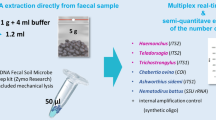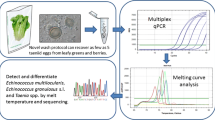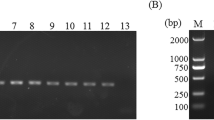Abstract
The purpose of this study was to evaluate the practicality of using real-time PCR for quantifying feces-derived trichostrongyle eggs. Haemonchus contortus eggs were used to evaluate fecal contaminants, time after egg embryonation, and the presence of competing and non-competing DNAs as factors that might interfere with generating reproducible results during simplex and multiplex quantitative real-time PCR (QPCR). Real-time PCR results showed linear quantifiable amplification with DNA from five to 75 eggs. However, threshold cycle (C T) values obtained by amplification of DNA from egg numbers between 75 and 1,000 did not differ significantly. Inhibitors of QPCR were effectively removed during DNA extraction as exemplified by the absence of any improvement in C T values with bovine serum albumin or phytase treatments. Changes from egg embryonation could only be detected during the first 6 h. Noncompetitive DNA did not appear to impact amplification; however, in a multiplex reaction a competing trichostrongyle such as Cooperia oncophora can hinder amplification of H. contortus DNA, when present at tenfold greater amounts. This study demonstrates the usefulness of QPCR for amplification and quantification of trichostrongyle eggs, and identifies potential limitations, which may be addressed through multiplex assays or the addition of a standard: exogenous DNA target.




Similar content being viewed by others
References
Álvarez-Sánchez MA, Pérez-García J, Cruz-Rojo MA, Rojo-Vázquez FA (2005) Real time PCR for the diagnosis of benzimidazole resistance in trichostrongylids of sheep. Vet Parasit 129:291–298
Christie M, Jackson F (1982) Specific identification of strongyle eggs in small samples of sheep faeces. Res Vet Sci 32:113–117
Cox DD, Todd AC (1962) Survey of gastrointestinal parasitism in Wisconsin dairy cattle. J Am Vet Med Assoc 141:706–709
Inglis GD, Kalischuk LD (2004) Direct quantification of Campylobacter jejuni and Campylobacter lanienae in feces of cattle by real-time quantitative PCR. Appl Environ Microbiol 70:2296–2306
Kaplan RM (2004) Drug resistance in nematodes of veterinary importance: a status report. Trends Parasitol 20:477–481
Kreader CA (1996) Relief of amplification inhibition in PCR with bovine serum albumin or T4 gene 32 protein. Appl Environ Microbiol 62(3):1102–1106
Harmon AF, Zarlenga DS, Hildreth MB (2006) Improved methods for isolating DNA from Ostertagia ostertagi eggs in cattle feces. Vet Parasitol 135:297–302
Lier T, Simonsen GS, Haaheim H, Hjelmevoll SO, Vennervald BJ, Johansen MV (2006) Novel real-time PCR for detection of Schistosoma japonicum in stool. Southeast Asian J Trop Med Public Health 37(2):257–264
Mejia ME, Fernandez Iqartua BM, Schmidt EE, Cabaret J (2003) Multispecies and multiple anthelmintic resistance on cattle nematodes in a farm in Argentina: the beginning of high resistance? Vet Res 34(4):461–468
Monteiro L, Bonnemaison D, Vekris A, Petry KG, Bonnet J, Vidal R, Cabrita J, Megraud F (1997) Complex polysaccharides as PCR inhibitors in feces: Helicobacter pylori model. J Clin Microbiol 35:995–998
Schnieder T, Heise M, Epe C (1999) Genus-specific PCR for the differentiation of eggs or larvae from gastrointestinal nematodes of ruminants. Parasitol Res 85:895–898
Schnyder M, Torqerson PR, Schonmann M, Kohler L, Hertzberg H (2005) Multiple anthelmintic resistance in Haemonchus contortus isolated from South African Boer goats in Switzerland. Vet Parasitol 128(3–4):3–4
Thornton CG, Passe S (2004) Inhibition of PCR amplification by phytic acid, and treatment of bovine fecal specimens with phytase to reduce inhibition. J Microbiol Methods 59:43–52
Von Samson-Himmelstjerna G, Harder A, Schnieder T (2002) Quantitative analysis of ITS2 sequences in trichostrongyle parasites. Int J Parasitol 32:1529–1535
Von Samson-Himmelstjerna G, Buschbaum S, Wirtherle N, Pape M, Schnieder T (2003) TaqMan minor groove binder real-time PCR analysis of B-tubulin codon 200 polymorphism in small strongyles (Cyathostomin) indicates that the TAC allele is only moderately selected in benzimidazole-resistant populations. Parasitology 127:489–496
Von Samson-Himmelstjerna G (2006) Molecular diagnosis of anthelmintic resistance. Vet Parasitol 136(2):99–107
Zarlenga DS, Gasbarre LC, Boyd PC, Leighton E, Lichtenfels JR (1998) Identification and semi-quantitation of Ostertagia ostertagi eggs by enzymatic amplification of ITS-1 sequences. Vet Parasitol 77:245–257
Zarlenga DS, Chute MB, Gasbarre LC, Boyd PC (2001) A multiplex PCR assay for differentiating economically important gastrointestinal nematodes of cattle. Vet Parasitol 97:199–209
Acknowledgements
This paper was approved for publication as Journal Series No.3552 by the Director, Agricultural Experiment Station, South Dakota State University. We would like to thank Dr. Larry Holler for his contribution with establishing our lab strain of H. contortus. Institutional animal care and use committee approval was obtained before this study. All experiments performed herein were in compliance with U.S. laws.
Author information
Authors and Affiliations
Corresponding author
Additional information
This work was supported in parts by Pfizer Animal Health, South Dakota State University Research Support Grant, the SDSU Functional Genomics Core Facility, and the South Dakota State University Agricultural Experiment Station.
Rights and permissions
About this article
Cite this article
Harmon, A.F., Williams, Z.B., Zarlenga, D.S. et al. Real-time PCR for quantifying Haemonchus contortus eggs and potential limiting factors. Parasitol Res 101, 71–76 (2007). https://doi.org/10.1007/s00436-006-0428-0
Received:
Accepted:
Published:
Issue Date:
DOI: https://doi.org/10.1007/s00436-006-0428-0




